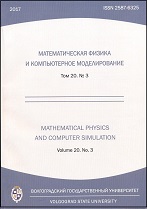|
Physics and astronomy
Method of numerical solution quantum few-body scattering problem
S. A. Pozdneev
P. N. Lebedev Physical Institute of the Russian Academy of Sciences, Moscow
Abstract:
A methods of numerical solution of the Faddeev equations for the bound and scattering state problems are presented. To solve the Faddeev's equations with corresponding boudary conditions the method is used wich is a generalization of the colon scheme of solution of Schrodinger equations. In this method a finit-difference approximation of equations in polar coordinates is used. By means of the net with knots on the arc and knots on the beam the finit-difference approximation of Faddeev's equations is performed. The increase the calculation accurace and to provide an effetive operation of the corresponding software support the net knots must be located nonuiformly are disscased.The net must be dens in the regions adjacent to an axes $x = 0$, while at $\rightarrow \infty$ becomes less dense. Such an arrangment of the net rnots is necessary for sufficienty accurate description of the complex behaviour of wave function in the region, where $x \ll y$. In the region $\rightarrow \infty$ the wave function takesasymptotical depends smoothly on angular variable, hence in this region the net must be chosen to be less dense. At calculations on the inhomogeneous net, in very important to comply with the condition of self-consistence, which implies that the error due to introducing the cut off radius must be far less than the quantizing error in the vicinty of boundary. The stability and self-consistence of the calculations may be check by various methods determinations of the net, the cut off radius and the scattering amplitude. This approach to the numerical solution of the Faddeev' equations combines the advantages of integral equations (the solution existens and uniqieness) with the computational scheme simplicity. Also it has the advantage that unknow two-particle quantities are specified not T-matrices but potentials and eigenfunctions corresponding to the bound states. The simplicity of the computational algorithm allows to consider few-body problems in real systems. The results of calculations binding energies and scattering state of are presented.
Keywords:
mathemanical simulation, quantum theory of scattering, Faddeev equation, Efimov effect.
Received: 29.11.2021
Accepted: 22.05.2022
Citation:
S. A. Pozdneev, “Method of numerical solution quantum few-body scattering problem”, Mathematical Physics and Computer Simulation, 25:3 (2022), 58–72
Linking options:
https://www.mathnet.ru/eng/vvgum335 https://www.mathnet.ru/eng/vvgum/v25/i3/p58
|

|




 Contact us:
Contact us: Terms of Use
Terms of Use
 Registration to the website
Registration to the website Logotypes
Logotypes








 Citation in format
Citation in format 